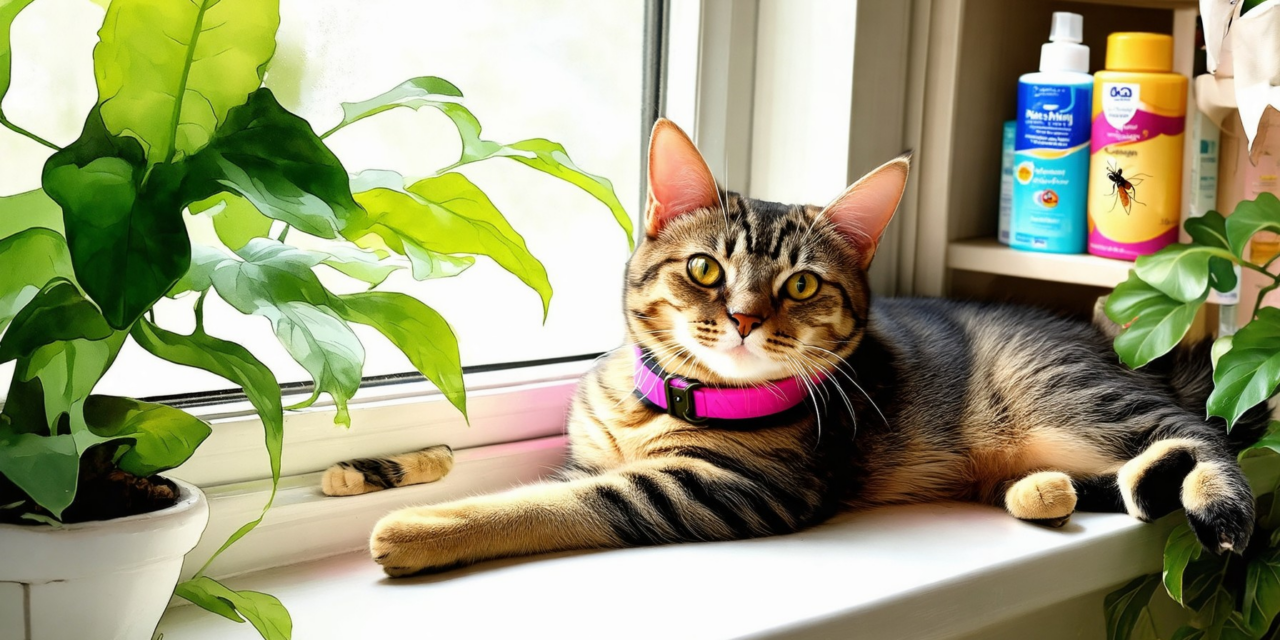Key Takeaways
- Comprehensive Protection: Frontline Plus for Cats combines fipronil and (S)-methoprene to effectively kill adult fleas and prevent future infestations by disrupting the flea lifecycle.
- Potential Side Effects: Common reactions include skin irritation, itching, and mild gastrointestinal upset; consult your vet if severe symptoms occur.
- Effective Application: Apply Frontline Plus directly to the skin between the shoulder blades for optimal results; avoid bathing your cat for 48 hours post-application.
- Purchase Options: Frontline Plus is readily available at retailers like Walmart and Costco, often with competitive pricing and promotions.
- Veterinary Guidance: Always consult your veterinarian before starting any flea treatment to ensure it’s suitable for your cat’s specific health needs.
Welcome to our comprehensive guide on Frontline Plus for Cats, where we delve into everything you need to know about this popular flea and tick treatment. As a responsible pet owner, understanding the efficacy, potential side effects, and available alternatives to Frontline Plus is crucial for ensuring your feline friend remains healthy and comfortable. In this article, we will explore key topics such as the differences between Frontline and Frontline Plus for Cats, reviews from other cat owners, and the common side effects associated with these treatments. Additionally, we will address frequently asked questions, including why Frontline may not be effectively eliminating fleas and whether it can tackle other pests like worms. By the end of this guide, you will be equipped with the knowledge to make informed decisions about your cat’s flea treatment options, including insights on pricing and where to purchase Frontline for Cats at retailers like Walmart and Costco. Join us as we uncover the facts about Frontline Plus for Cats and help you keep your furry companion safe and pest-free.
What is the difference between Frontline and Frontline Plus for cats?
The primary difference between FRONTLINE® and FRONTLINE PLUS® for cats lies in their formulation and effectiveness against fleas and ticks. Understanding these differences can help you choose the best flea treatment for your feline friend.
Frontline Plus for Cats Reviews
Both FRONTLINE® SPOT ON and FRONTLINE PLUS® contain fipronil, which effectively kills adult fleas and ticks. However, FRONTLINE PLUS® includes an additional ingredient called (S)-methoprene, an insect growth regulator (IGR) that prevents flea eggs and larvae from developing into adult fleas. This dual-action formula is often highlighted in Frontline official site reviews, where pet owners appreciate the added protection against future infestations.
While FRONTLINE® SPOT ON kills existing fleas and ticks, FRONTLINE PLUS® offers a more comprehensive solution by disrupting the flea lifecycle. This means that not only does it eliminate adult fleas and ticks, but it also prevents new infestations by stopping flea eggs from hatching and larvae from maturing. According to the American Veterinary Medical Association, using products that disrupt the flea lifecycle is crucial for effective pest management in pets.
Both products provide protection for up to 30 days, but the added IGR in FRONTLINE PLUS® ensures longer-lasting control over flea populations in your home environment. For pet owners seeking to maintain a flea-free environment, FRONTLINE PLUS® is often recommended due to its enhanced protection.
Frontline for Cats at Walmart
If you’re looking to purchase FRONTLINE® or FRONTLINE PLUS® for your cat, Walmart is a convenient option. You can find various formulations, including the popular frontline for cats and frontline flea treatment options. Walmart often offers competitive pricing, making it easier to keep your cat protected from fleas and ticks without breaking the bank.
When shopping at Walmart, be sure to check for any available discounts on Chewy or Frontline products to ensure you’re getting the best deal. Additionally, always read the product labels to confirm you’re selecting the right treatment for your cat’s specific needs.

What are the negative side effects from Frontline?
Frontline® is a popular topical treatment for fleas and ticks in dogs and cats, but like any medication, it can have side effects. While most pets tolerate Frontline® well, some may experience mild reactions. Common side effects include:
- Itching or scratching at the application site
- Redness or irritation of the skin
- Hair loss around the area of application
If your pet shows signs of skin irritation, it is advisable to bathe them with a mild soap and rinse thoroughly with water.
In rare cases, pets may experience more severe side effects, such as:
- Drooling
- Vomiting
- Diarrhea
- Lethargy or unusual behavior
If any of these symptoms occur, it is crucial to contact your veterinarian immediately for guidance.
It’s important to note that while Frontline® is generally safe, individual reactions can vary based on the pet’s health, age, and any pre-existing conditions. Always consult with your veterinarian before starting any new treatment to ensure it is appropriate for your pet’s specific needs. For more detailed information on pet medications and their effects, resources such as the American Veterinary Medical Association (AVMA) and the Food and Drug Administration (FDA) provide comprehensive guidelines and updates on pet health and safety.
Frontline Plus Cats Side Effects
When considering Frontline Plus for cats, it’s essential to be aware of potential side effects specific to this formulation. Similar to Frontline®, Frontline Plus may cause:
- Skin irritation or sensitivity
- Increased scratching or grooming behavior
- Occasional gastrointestinal upset
Monitoring your cat after application is crucial. If you notice any unusual behavior or persistent symptoms, consult your veterinarian for advice tailored to your cat’s health.
Side Effects of Frontline in Cats
Understanding the side effects of Frontline in cats can help pet owners make informed decisions. While most cats handle the treatment well, some may exhibit:
- Allergic reactions, which can manifest as swelling or hives
- Changes in appetite or energy levels
- Behavioral changes, such as increased anxiety or restlessness
Always ensure that your cat is healthy and consult with your veterinarian before starting any flea treatment, including Frontline. This proactive approach can help mitigate any adverse effects and ensure your cat’s well-being.
What are the negative side effects from Frontline?
While Frontline Plus for cats is widely used for flea and tick prevention, it’s essential to be aware of potential side effects. Understanding these side effects can help you make informed decisions about your cat’s health and well-being. Here are some common side effects associated with Frontline Plus:
Frontline Plus Cats Side Effects
- Skin Irritation: Some cats may experience localized skin irritation at the application site, including redness or itching. This is usually mild and resolves on its own.
- Gastrointestinal Upset: In rare cases, cats may experience vomiting or diarrhea after application. If this occurs, monitor your cat and consult your veterinarian if symptoms persist.
- Behavioral Changes: Some pet owners report changes in behavior, such as increased agitation or lethargy. If you notice significant changes, it’s advisable to seek veterinary advice.
- Allergic Reactions: Although uncommon, some cats may have an allergic reaction to the ingredients in Frontline Plus. Symptoms can include swelling, difficulty breathing, or hives. Immediate veterinary attention is necessary in these cases.
For more detailed information on the side effects of Frontline, you can refer to the ASPCA for pet care resources.
Side Effects of Frontline in Cats
It’s crucial to apply Frontline Plus correctly to minimize the risk of side effects. Here are some tips to ensure safe application:
- Not Reaching the Skin: Ensure you are applying Frontline directly to your cat’s skin by parting the fur to expose the skin. This is crucial for the product to be effective, as it needs to penetrate the skin to work properly.
- Not Using the Entire Dose: It’s essential to completely empty the tube during application. The dosage is specifically measured for your pet’s weight, and using the full amount is necessary for optimal effectiveness.
- Applying in the Wrong Place: While most topical flea treatments recommend application at the base of the neck, some may require application in multiple spots along your cat’s back. Always refer to the specific instructions for the product you are using.
- Not Following Instructions: Carefully read and adhere to the instructions provided on the package. Misapplication can significantly reduce the effectiveness of the treatment.
If you suspect that your cat is experiencing side effects from Frontline, consult your veterinarian for personalized advice and potential alternatives. For more information on flea treatments, check out our article on cat flea treatment.
Does Frontline Plus Get Rid of Worms in Cats?
Frontline Plus is primarily designed to eliminate fleas and ticks in cats, but it also has some efficacy against certain intestinal worms. Specifically, it targets roundworms and tapeworms. The active ingredients in Frontline Plus, fipronil and (S)-methoprene, work together to kill adult fleas and ticks while preventing flea eggs from hatching, thus providing comprehensive protection against infestations.
However, for a more effective treatment against worms, it is recommended to use a dedicated dewormer, such as praziquantel for tapeworms or pyrantel pamoate for roundworms. These medications are specifically formulated to target and eliminate intestinal parasites, ensuring a thorough approach to your cat’s health.
For optimal results, consult with a veterinarian to determine the best treatment plan for your cat, as they can provide tailored advice based on your pet’s specific needs and health status. Regular veterinary check-ups and fecal examinations can also help in monitoring and preventing worm infestations.
In summary, while Frontline Plus provides some level of protection against worms, it is not a comprehensive solution. Combining it with a specific deworming treatment will ensure your cat remains healthy and free from parasites. Always prioritize veterinary guidance for the best outcomes in pet health management.
Frontline Plus for Cats Active Ingredients
The effectiveness of Frontline Plus for cats largely hinges on its active ingredients. Fipronil is a potent insecticide that disrupts the nervous system of fleas and ticks, leading to their death. Meanwhile, (S)-methoprene acts as an insect growth regulator, preventing flea eggs and larvae from developing into adult fleas. This dual-action formula not only eliminates existing fleas and ticks but also helps prevent future infestations.
Understanding these ingredients can help pet owners make informed decisions about flea and tick prevention. For those considering alternatives, it’s essential to compare the active ingredients in other flea treatments, such as those available at Chewy or the Frontline official site, to ensure they meet your cat’s specific needs.

Do Fleas Fall Off Cats After Treatment?
Understanding the effectiveness of flea treatments like Frontline Plus for cats is crucial for pet owners. After applying Frontline Plus for cats, many pet owners wonder if fleas will fall off their cats. The answer is generally yes, but the timing and effectiveness can vary based on several factors.
Frontline Plus for Cats How to Apply
To ensure that Frontline Plus for cats works effectively, proper application is key. Here’s how to apply it:
- Choose the Right Spot: Apply the treatment directly to the skin between the shoulder blades, where your cat cannot lick it off.
- Ensure Dry Fur: Make sure your cat’s fur is dry before application to allow the product to penetrate the skin effectively.
- Follow Dosage Instructions: Use the appropriate dosage based on your cat’s weight, as indicated on the packaging.
- Avoid Bathing: Do not bathe your cat for at least 48 hours after application to ensure the treatment is absorbed properly.
After treatment, fleas typically begin to die within 24 hours, and many will fall off your cat as they die. However, it’s important to note that some fleas may remain on your cat for a short period before they are eliminated. Regularly checking your cat for fleas and maintaining a clean environment will help ensure the effectiveness of Frontline flea treatment for cats.
Reviews on Frontline Plus for Cats
Many pet owners have shared their experiences with Frontline Plus for cats. Reviews often highlight its effectiveness in controlling flea populations and preventing re-infestation. Users appreciate that it not only targets fleas but also ticks, making it a comprehensive solution for pet health. However, some reviews mention occasional side effects, which can vary from cat to cat.
For detailed insights, consider checking Frontline official site for more information on their products and to read customer testimonials. Additionally, exploring PetMD can provide further guidance on flea treatments and overall pet care.
Do Fleas Fall Off Cats After Treatment?
Fleas can indeed fall off cats after treatment, but understanding the dynamics of flea treatments and the flea life cycle is essential for effective management.
1. **Mechanism of Flea Treatments**: Most flea treatments function by either killing fleas on contact or disrupting their reproductive cycle. Topical treatments, such as those containing active ingredients like imidacloprid or fipronil, are designed to eliminate adult fleas quickly. However, some fleas may remain due to their life cycle stages or new infestations from the environment.
2. **Timeframe for Flea Death**: Fleas typically begin to die within 24 hours of exposure to effective treatments. However, it may take longer for pet owners to notice a significant reduction in flea activity, as some fleas may become more active before succumbing to the treatment.
3. **Factors Influencing Flea Presence**: The duration of visible fleas on treated cats can depend on several factors:
– **Severity of Infestation**: Heavily infested environments may lead to a prolonged presence of fleas.
– **Type of Treatment**: Different products have varying efficacy rates and may require multiple applications for complete control.
– **Environmental Conditions**: Fleas can jump back onto treated pets from untreated areas in the home or yard, making comprehensive treatment of the environment crucial.
4. **Understanding the Flea Life Cycle**: Fleas undergo a life cycle that includes eggs, larvae, pupae, and adults. While treatments effectively kill adult fleas on the cat, new fleas can emerge from pupae in the environment, leading to a resurgence of fleas even after treatment.
5. **Long-Term Management**: Complete eradication of fleas may require several months of consistent treatment, especially if the home is also infested. Regular vacuuming, washing pet bedding, and using environmental flea control products can help reduce the flea population.
6. **Expert Recommendations**: Veterinary professionals often recommend a multi-faceted approach to flea control, which includes treating all pets in the household and addressing the home environment. For further guidance, resources such as the American Veterinary Medical Association (AVMA) and the Centers for Disease Control and Prevention (CDC) provide valuable insights into effective flea management strategies.
Frontline Plus for Cats How to Apply
Applying Frontline Plus for cats is straightforward, but following the correct procedure ensures maximum effectiveness. Here’s how to apply it:
1. **Preparation**: Ensure your cat is dry and healthy before application. Do not bathe your cat for 24 hours before or after applying the treatment.
2. **Application Site**: Choose a spot on the back of the neck, between the shoulder blades, where your cat cannot lick it off. This area is ideal as it minimizes the chance of ingestion.
3. **Dispensing the Product**: Hold the applicator upright and snap off the tip. Part the fur at the application site to expose the skin. Squeeze the applicator to apply the entire contents directly onto the skin.
4. **Post-Application Care**: Avoid bathing your cat for at least 24 hours after application to allow the treatment to spread effectively. Monitor your cat for any adverse reactions.
5. **Frequency of Application**: Frontline Plus should be reapplied every 30 days for optimal flea and tick control.
For more detailed instructions, you can refer to the [Frontline official site](https://www.frontline.com/) for additional resources and product information.
Reviews on Frontline Plus for Cats
Frontline Plus for cats has garnered a variety of reviews from pet owners. Many users appreciate its effectiveness in controlling fleas and ticks, noting that their cats show significant improvement shortly after application.
– **Positive Feedback**: Users often highlight the ease of application and the long-lasting effects, with many reporting that their cats remain flea-free for the entire month after treatment.
– **Concerns**: Some reviews mention side effects such as mild skin irritation or excessive grooming immediately after application. It’s essential to monitor your cat for any adverse reactions and consult a veterinarian if necessary.
Overall, Frontline Plus for cats is a popular choice among pet owners for its reliability and effectiveness in flea and tick prevention. For more insights, check out [Frontline Plus reviews for cats](https://www.chewy.com/) to see what other pet owners are saying.
What is the difference between Frontline and Frontline Plus for cats?
Frontline and Frontline Plus for cats are both popular flea and tick treatments, but they differ significantly in their formulation and effectiveness. Frontline contains fipronil, which targets adult fleas and ticks, while Frontline Plus includes an additional ingredient, (S)-methoprene, that disrupts the life cycle of fleas by preventing eggs and larvae from developing. This dual-action formula makes Frontline Plus more effective in controlling flea infestations over time.
Frontline Plus for Cats Reviews
Reviews for Frontline Plus for cats are generally positive, with many pet owners noting its effectiveness in eliminating fleas and ticks. Users appreciate the ease of application and the long-lasting protection it offers. However, some reviews mention that it may take a few days to see a significant reduction in flea activity. Overall, Frontline Plus is often recommended as a reliable choice for flea and tick prevention.
Frontline for Cats at Walmart
Walmart offers a variety of Frontline products, including Frontline for cats and Frontline Plus for cats. Customers can find competitive prices and convenient purchasing options, making it a popular choice for pet owners. It’s advisable to check for availability and compare prices, as Walmart frequently has promotions on pet care products. For more information, visit the Walmart Frontline for Cats page.
What are the negative side effects from Frontline?
While Frontline is generally safe for cats, some pets may experience side effects. Common side effects include mild skin irritation at the application site, lethargy, or gastrointestinal upset. In rare cases, more severe reactions such as seizures or allergic responses may occur. If you notice any concerning symptoms after applying Frontline, consult your veterinarian for guidance.
Frontline Plus Cats Side Effects
Frontline Plus for cats can also cause side effects similar to those of regular Frontline. Most cats tolerate the treatment well, but some may show signs of sensitivity, such as excessive scratching or redness at the application site. Monitoring your cat after treatment is essential, and if any severe reactions occur, immediate veterinary attention is recommended.
Side Effects of Frontline in Cats
In addition to the side effects mentioned, some cats may experience behavioral changes, such as increased anxiety or restlessness. These reactions are typically temporary and resolve within a few hours to a day. Always ensure that your cat is healthy before applying any flea treatment, and consult with your veterinarian if you have concerns about potential side effects.













